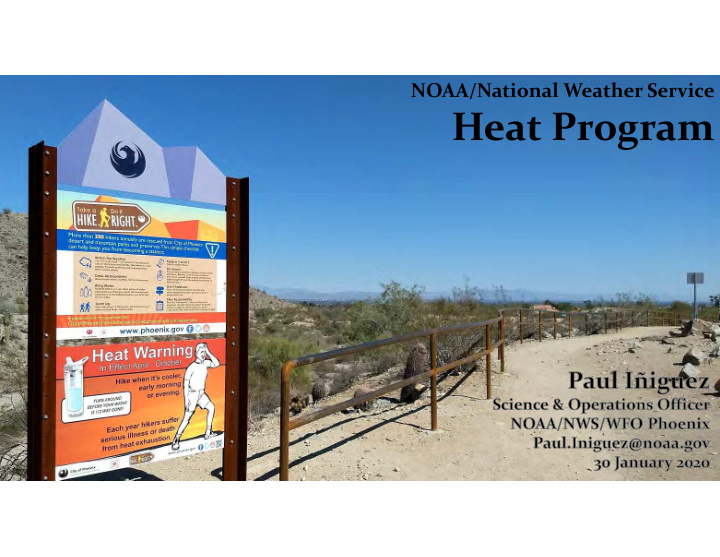



NOAA/National Weather Service Heat Program
Challenge: Risk Perception Source: NOAA, ADHS
Challenge: Risk Perception Source: NOAA, ADHS
Challenge: Visual Threat
Challenge: Visual Threat Before Heat Wave After Heat Wave 75 °F 115 °F
Challenge: Arizona is Hot! PHX averages ~110 days of Normal high temperature Average 8 days with a low 100+ °F each year. for July is 106 °F. temperature of 90+ °F.
Challenge: Getting Hotter
Challenge: Getting Hotter
Challenge: Getting Hotter Last Record Low: Aug. 28, 2008
NOAA/NWS Heat Services To address these challenges, NOAA/NWS conducts a number of activities and offers a number of services. – Temperature Forecast • Includes HeatRisk product – Social Media – Partner (Email) Briefings – Official Alerts -- “Biggest Bells” to Ring – Extensive Partner Interaction
Temperature Forecasts Weather.Gov/Phoenix
Temperature Forecasts 1-mile by 1-mile Grid ~800 in Phoenix Area 3,783 in Maricopa County 47,083 in Arizona
Temperature Forecasts
HeatRisk • A flexible Framework • Puts NWS forecast high & low temperatures into a climatological context based on location & time of year. • Considers duration of expected heat. • Humidity is indirectly accounted for in elevated low temperatures. • Official method for determining when & where to issue official heat alerts across the Western U.S. https://www.wrh.noaa.gov/wrh/heatrisk/
How Does HeatRisk Work? Red (High) ~95 th Percentile Orange (Mod) Seasonal Split Yellow (Low) CDC Collaboration Similar Process for Low Temperatures
How Does HeatRisk Work? Yellow Orange Red HeatRisk High Temperature Thresholds – July 4
How Does HeatRisk Work? None Official NWS Forecast Low Mod (High & Low Temperature) High NWS HeatRisk Very High Thresholds
Phoenix Flagstaff Alpine HeatRisk - 2019
Heat & Drought
NOAA/NWS Heat Policy The NOAA/NWS HeatRisk product is used to determine our messaging tone and actions across Arizona. – Verbiage in social media/briefing material – When & where to issue official heat alerts
NWS Heat Alerts • Excessive Heat Warning – High Confidence (80%+) – HeatRisk of High (red) or Very High (magenta) – High/Very High Impact Level (e.g., increased morbidity) Expected – May be preceded by “Excessive Heat Watch” (confidence 50%) • Heat Advisory – High Confidence (80%+) – For AZ, High Elevation Areas Only (~5,000’+) – HeatRisk of Moderate (orange) – Moderate/High Impact Level Expected
Frequency of Heat Alerts Heat Warnings Heat Advisory (2017-2019) (2017-2019)
Historical SW June 2017 • Nearly 350 (250) daily MaxT (MinT) temperature records were tied and almost 800 (800) were broken across the West. • Impacts: power disruptions, flight cancelations, and an increase in heat morbidity/mortality. • In Maricopa County, AZ alone (location of Phoenix), roughly 50 heat-related deaths occurred.
Historical SW June 2017 HeatRisk & NWS Alerts Note Excellent Coordination/Consistency Across the Southwest! EXCESSIVE HEAT WATCH EXCESSIVE HEAT WARNING HEAT ADVISORY
Partner Usage of HeatRisk
Messaging Heat
This summer will be hot! There will be extreme heat! Be prepared! Paul.Iniguez@noaa.gov | Weather.Gov
Recommend
More recommend